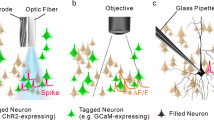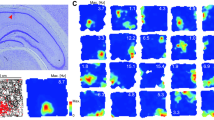This review of the literature analyzes knowledge of the higher, integrative level of the physiological system by which animals orient themselves in space. Studies of the patterns of operation of the system at this level are relevant as impairments may underlie degradation of the ability to orient in space (spatial agnosia), an important sign of a number of brain diseases, particularly Alzheimer’s disease. Studies over recent decades have identified the main functional components of the system integrating information on an animal’s spatial position. The significance of these findings is reflected in a number of prestigious awards and honors, including the 2014 Nobel Prize in Physiology and Medicine.
Similar content being viewed by others
References
E. V. Astacheva, “Studies of the oscillatory activity and interstructural relationships in the limbic system,” Fund. Issled., No. 12–4, 699–703 (2011).
R. M. Borisyuk, “Modeling of the hippocampal theta rhythm,” Zh. Vyssh. Nerv. Deyat., 54, No. 1, 85–100 (2004).
I. E. Mysin, Ya. B. Kazanovich, and V. F. Kichigina, “Modeling of the neural network of the medial septal region as a pacemaker of the theta rhythm,” Fund. Issled., No. 11–4, 691–695 (2013).
V. D. Tsukerman, Z. S. Eremenko, O. V. Karimova, et al., “A mathematical model of spatial coding in the hippocampal formation. I. Neurodynamics of grid cells,” Matemat. Biol. Bioinformat., 7, No. 1, 206–243 (2012).
M. I. Anderson and K. J. Jeffery, “Heterogeneous modulation of place cell firing by changes in context,” J. Neurosci., 23, No. 26, 8827–8835 (2003).
C. Barry, L. L. Ginzberg, J. O’Keefe, and N. Burgess, “Grid cell firing patterns signal environ-mental novelty by expansion,” Proc. Natl. Acad. Sci. USA, 109, No. 43, 17687–17692 (2012).
C. Barry, C. Lever, R. Hayman, et al., “The boundary vector cell model of place cell firing and spatial memory,” Rev. Neurosci., 17, No. 1–2, 71–97 (2006).
C. N. Boccara, F. Sargolini, V. H. Thoresen, et al., “Grid cells in pre-and parasubiculum,” Nat. Neurosci., 13, No. 8, 987–994 (2010).
V. H. Brun, T. Solstad, K. B. Kjelstrup, et al., “Progressive increase in grid scale from dorsal to ventral medial entorhinal cortex,” Hippocampus, 18, No. 12, 1200–1212 (2008).
N. Burgess and J. O’Keefe, “Models of place and grid cell firing and theta rhythmicity,” Curr. Opin. Neurobiol., 21, No. 5, 734–744 (2011).
F. Cacucci, M. Yi, T. J. Wills, et al., “Place cell firing correlates with memory deficits and amyloid plaque burden in Tg2576 Alzheimer mouse model,” Proc. Natl. Acad. Sci. USA, 105, No. 22, 7863–7868 (2008).
M. J. Chadwick, A. E. J. Jolly, D. P. Amos, et al., “A goal direction signal in the human entorhinal/subicular region,” Curr. Biol., 25, No. 1, 87–92 (2015).
G. Chen, J. A. King, N. Burgess, and J. O’Keefe, “How vision and movement combine in the hippocampal place code,” Proc. Natl. Acad. Sci. USA, 110, No. 1, 378–383 (2013).
B. J. Clark and J. S. Taube, “Vestibular and attractor network basis of the head direction cell signal in subcortical circuits,” Front Neural Circuits, 6 (2012).
L. L. Colgin, “Mechanisms and functions of theta rhythms,” Ann. Rev. Neurosci., 36, No. 1, 295–312 (2013).
A. R. Deipolyi, K. P. Rankin, L. Mucke, et al., “Spatial cognition and the human navigation network in AD and MCI,” Neurology, 69, No. 10, 986–997 (2007).
G. Dragoi and S. Tonegawa, “Distinct preplay of multiple novel spatial experiences in the rat,” Proc. Natl. Acad. Sci. USA, 110, No. 22, 9100–9105 (2013).
G. Dragoi and S. Tonegawa, “Selection of preconfigured cell assemblies for representation of novel spatial experiences,” Philos. Trans. R. Soc. B. Biol. Sci., 369, No. 1635, 20120522 (2014).
A. S. Etienne and K. J. Jeffery, “Path integration in mammals,” Hippocampus, 14, No. 2, 180–192 (2004).
D. J. Foster and M. A. Wilson, “Reverse replay of behavioural sequences in hippocampal place cells during the awake state,” Nature, 440, No. 7084, 680–683 (2006).
M. Fyhn, S. Molden, M. P. Witter, et al., “Spatial representation in the entorhinal cortex,” Science, 305, No. 5688, 1258–1264 (2004).
C. C. Guariglia and R. Nitrini, “Topographical disorientation in Alzheimer’s disease,” Arq. Neuropsiquiatr., 67, No. 4, 967–972 (2009).
T. Hafting, M. Fyhn, S. Molden, et al., “Microstructure of a spatial map in the entorhinal cortex,” Nature, 436, No. 7052, 801–806 (2005).
T. Hartley, C. Lever, N. Burgess, and J. O’Keefe, “Space in the brain: how the hippocampal formation supports spatial cognition,” Philos. Trans, R. Soc. B., 369, No. 1635, 20120510 (2014).
M. E. Hasselmo, C. Bodelon, and B. P. Wyble, “A Proposed function for hippocampal theta rhythm: separate phases of encoding and retrieval enhance reversal of prior learning,” Neural Computation, 14, No. 4, 793–817 (2002).
J. Jacobs, “Hippocampal theta oscillations are slower in humans than in rodents: implications for models of spatial navigation and memory,” Philos. Trans. R. Soc. B. Biol. Sci., 369, No. 1635 (2014).
J. Jacobs, C. T. Weidemann, J. F. Miller, et al., “Direct recordings of grid-like neuronal activity in human spatial navigation,” Nat. Neurosci., 16, No. 9, 1188–1190 (2013).
A. Johnson, K. Seeland, and A. D. Redish, “Reconstruction of the postsubiculum head direction signal from neural ensembles,” Hippocampus, 15, No. 1, 86–96, No. 2005.
M. W. Jung, S. I. Wiener, and B. L. McNaughton, “Comparison of spatial firing characteristics of units in dorsal and ventral hippocampus of the rat,” J. Neurosci., 14, No. 12, 7347–7356 (1994).
K. Kang, M. Shelley, and H. Sompolinsky, “Mexican hats and pinwheels in visual cortex,” Proc. Natl. Acad. Sci. USA, 100, No. 5, 2848–2853 (2003).
K. B. Kjelstrup, T. Solstad, V. H. Brun, et al., “Finite scale of spatial representation in the hippocampus,” Science, 321, No. 5885, 140–143 (2008).
E. Kropff Causa, J. E. Carmichael, R. Baldi, et al., “Modulation of hippocampal and entorhinal theta frequency by running speed and acceleration,” Soc. Neurosci. Abstr., 39 (2013).
S. Kuhn and J. Gallinat, “Segregating cognitive functions within hippocampal formation: A quantitative meta-analysis on spatial navigation and episodic memory,” Hum. Brain Mapp., 35, No. 4, 1129–1142 (2014).
A. K. Lee and M. A. Wilson, “Memory of sequential experience in the hippocampus during slow wave sleep,” Neuron, 36, No. 6, 1183–1194 (2002).
C. Lever, S. Burton, A. Jeewajee, et al., “Boundary vector cells in the subiculum of the hippocampal formation,” J. Neurosci., 29, No. 31, 9771–9777 (2009).
B. E. Levin, “Spatial cognition in Parkinson disease,” Alzheimer Dis. Assoc. Disord., 4, No. 3, 161–170 (1990).
B. L. McNaughton, F. P. Battaglia, O. Jensen, et al., “Path integration and the neural basis of the ‘cognitive map,’” Nat. Rev. Neurosci., 7, No. 8, 663–678 (2006).
E. I. Moser, E. Kropff, and M.-B. Moser, “Place cells, grid cells, and the brain’s spatial representation system,” Ann. Rev. Neurosci., 31, No. 1, 69–89 (2008).
E. I. Moser and M.-B. Moser, “A metric for space,” Hippocampus, 18, No. 12, 1142–1156 (2008).
E. I. Moser, Y. Roudi, M. P. Witter, et al., “Grid cells and cortical representation,” Nat. Rev. Neurosci., 15, No. 7, 466–481 (2014).
M.-B. Moser, D. C. Rowland, and E. I. Moser, “Place cells, grid cells, and memory,” Cold Spring Harb. Perspect. Biol., 7, No. 2, a021808 (2015).
R. U. Muller, E. Bostock, J. S. Taube, and J. L. Kubie, “On the directional firing properties of hippocampal place cells,” J. Neurosci., 14, No. 12, 7235–7251 (1994).
R. U. Muller and J. L. Kubie, “The effects of changes in the environment on the spatial firing of hippocampal complex-spike cells,” J. Neurosci., 7, No. 7, 1951–1968 (1987).
The Nobel Prize in Physiology or Medicine 2014, Nobelprize.org, Nobel Media (2014).
J. O’Keefe and N. Burgess, “Geometric determinants of the place fields of hippocampal neurons,” Nature, 381, No. 6581, 425–428 (1996).
J. O’Keefe and D. H. Conway, “Hippocampal place units in the freely moving rat: Why they fire where they fire,” Exp. Brain Res., 31, No. 4, 573–590 (1978).
J. O’Keefe and J. Dostrovsky, “The hippocampus as a spatial map. Preliminary evidence from unit activity in the freely-moving rat,” Brain Res., 34, No. 1, 171–175 (1971).
J. O’Keefe and L. Nadel, “The hippocampus as a cognitive map,” Behav. Brain Sci., 2, No. 4, 487–533 (1978).
J. B. Ranckjr, Jr., “Head direction cells in the deep cell layer of dorsal presubiculum in freely moving rats,” Soc. Neurosci. Abstr., 10 (1984).
A. Samsonovich and B. L. McNaughton, “Path integration and cognitive mapping in a continuous attractor neural network model,” J. Neurosci., 17, No. 15, 5900–5920 (1997).
A. V. Samsonovich, “Continuous attractor network,” in: Scholarpedia: the Free Peer-Reviewed Encyclopedia, www.scholarpedia.org/article/Continuous_attractor_network (2010).
F. Sargolini, M. Fyhn, T. Hafting, et al., “Conjunctive representation of position, direction, and velocity in entorhinal cortex,” Science, 312, No. 5774, 758–762 (2006).
F. Savelli, D. Yoganarasimha, and J. J. Knierim, “Influence of boundary removal on the spatial representations of the medial entorhinal cortex,” Hippocampus, 18, No. 12, 1270–1282 (2008).
S. Serino, P. Cipresso, F. Morganti, and G. Riva,” The role of egocentric and allocentric abilities in Alzheimer’s disease: A systematic review,” Ageing Res. Rev., 16, 32–44 (2014).
T. Solstad, C. N. Boccara, E. Kropff, et al., “Representation of geometric borders in the entorhinal cortex,” Science, 322, No. 5909, 1865–1868 (2008).
R. W. Stackman and J. S. Taube, “Firing properties of rat lateral mammillary single units: head direction, head pitch, and angular head velocity,” J. Neurosci., 18, No. 21, 9020–9037 (1998).
H. Stensola, T. Stensola, T. Solstad, et al., “The entorhinal grid map is discretized,” Nature, 492, No. 7427, 72–78 (2012).
S. Stewart, A. Jeewajee, T. J. Wills, et al., “Boundary coding in the rat subiculum,” Philos. Trans. R. Soc. B. Biol. Sci. 369, No. 1635, 20120514 (2014).
J. S. Taube, “The head direction signal: origins and sensory-motor integration,” Ann. Rev. Neurosci., 30, No. 1, 181–207 (2007).
J. S. Taube, “Head direction cells recorded in the anterior thalamic nuclei of freely moving rats,” J. Neurosci., 15, No. 1, 70–86 (1995).
J. S. Taube, R. U. Muller, and J. B. Ranck, “Head-direction cells recorded from the postsubiculum in freely moving rats. I. Description and quantitative analysis,” J. Neurosci., 10, No. 2, 420–435 (1990).
J. S. Taube, R. U. Muller, and J. B. Ranck, “Head-direction cells recorded from the postsubiculum in freely moving rats. II. Effects of environmental manipulations,” J. Neurosci., 10, No. 2, 436–447 (1990).
E. C. Tolman, “Cognitive maps in rats and men,” Psychol. Rev., 55, No. 4, 189–208 (1948).
E. Y. Uc, M. Rizzo, S. W. Anderson, et al., “Impaired navigation in drivers with Parkinson’s disease,” Brain, 130, No. 9, 2433–2440 (2007).
C. H. Vanderwolf, “Hippocampal electrical activity and voluntary movement in the rat,” EEG Clin. Neurophysiol., 26, No. 4, 407–418 (1969).
M. A. Wilson and B. L. McNaughton, “Reactivation of hippocampal ensemble memories during sleep,” Science, 265, No. 5172, 676–679 (1994).
S.-J. Zhang, J. Ye, J. J. Couey, et al., “Functional connectivity of the entorhinal–hippocampal space circuit,” Philos. Trans. R. Soc. B., 369, No. 1635, 20120516 (2014).
S. Zhang and D. Manahan-Vaughan, “Spatial olfactory learning contributes to place field formation in the hippocampus,” Cereb. Cortex, 25, No. 2, 423–432 (2015).
R. Zhao, S. W. Fowler, A. C. A. Chiang, et al., “Impairments in experience-dependent scaling and stability of hippocampal place fields limit spatial learning in a mouse model of Alzheimer’s disease,” Hippocampus, 24, No. 8, 963–978 (2014).
Author information
Authors and Affiliations
Corresponding author
Additional information
Translated from Rossiiskii Fiziologicheskii Zhurnal imeni I. M. Sechenova, Vol. 102, No. 4, pp. 411–420, April, 2016.
Rights and permissions
About this article
Cite this article
Mukhin, V.N., Pavlov, K.I. & Klimenko, V.M. The Integrative Level of the Hierarchical Spatial Orientation System in Animals. Neurosci Behav Physi 47, 675–680 (2017). https://doi.org/10.1007/s11055-017-0454-7
Received:
Published:
Issue Date:
DOI: https://doi.org/10.1007/s11055-017-0454-7




